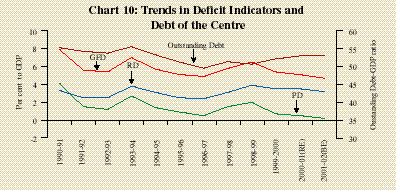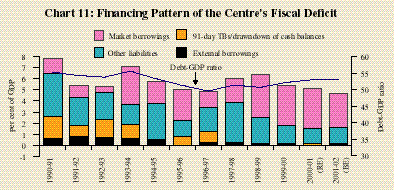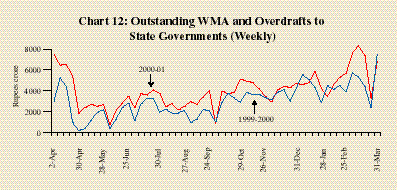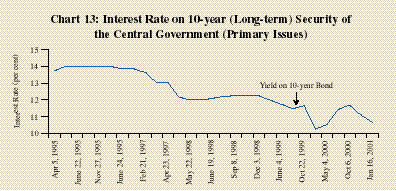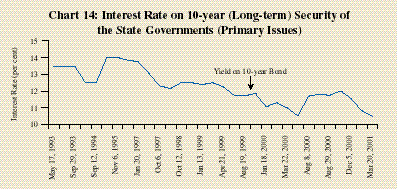II. Fiscal Situation - RBI - Reserve Bank of India
II. Fiscal Situation
Centre's Fiscal Position
The strategy of fiscal consolidation envisaged in the Union Budget 2000-01 focused upon bringing down the Centre's gross fiscal deficit (GFD) and revenue deficit (RD) to 5.1 per cent and 3.6 per cent of GDP, respectively. According to the revised estimates for 2000-01, both the revenue deficit and fiscal deficit were contained at the budgeted levels. The primary deficit (PD) is placed at Rs.11,305 crore (0.5 per cent of GDP) as against the budget estimate of Rs.10,009 crore (Chart 10). The deficit targets were achieved due to buoyancy in revenue receipts and reining in of expenditure, despite a shortfall in the realisation from disinvestments.
The revenue receipts (net to Centre) registered an increase of Rs.2,493 crore (1.2 per cent) mainly on account of non-tax revenue. Net tax revenue, however, suffered a decline of Rs.1,806 crore, primarily due to the shortfall in indirect taxes, viz., customs and union excise duties. Expenditure reduction was effected under both non-Plan and Plan categories. Aggregate expenditure was kept below the budget estimates by Rs.2,964 crore (0.9 per cent). The reduction in non-Plan expenditure by Rs.1,103 crore, despite the significant rise in expenditure on subsidies (Rs.5,569 crore), was on account of the reduction under pensions (Rs.1,311 crore), interest payments (Rs.599 crore), grants to States and Union Territories (UTs) (Rs.1,532 crore) and defence (Rs.4,126 crore). The plan expenditure was less than the budgeted level by 2.1 per cent (Rs.1,862 crore). The realisation from disinvestments was only Rs. 2,500 core as against the budgeted target of Rs. 10,000 crore.
The Union Budget projects the major deficit indicators for 2001-02 lower than their levels in the revised estimates for 2000-01. The gross fiscal deficit (GFD), budgeted at Rs.1,16,314 crore, is placed lower at 4.7 per cent of GDP as compared with 5.1 per cent for 2000-01. The revenue deficit is estimated at Rs.78,821 crore or 3.2 per cent of GDP as against 3.6 per cent in the revised estimate for 2000-01. The primary deficit is projected at Rs.4,014 crore, declining to 0.2 per cent of GDP from 0.5 per cent in 2000-01. The financing pattern of GFD indicates that during 2001-02, net market borrowing would finance 66.5 per cent of GFD, marginally lower than 69.0 per cent in the revised estimate for 2000-01. At the same time, financing through other liabilities would increase to 31.9 per cent from 27.5 per cent in 2000-01 and external finance would contribute 1.6 per cent as against 0.5 per cent in the previous year (Chart 11). The debt-GDP ratio is also placed marginally higher at 53.2 per cent as at end-March 2002 as against 53.0 per cent as at end-March 2001, although it is lower than the level of 55.3 per cent as at end-March 1991.
State Finances
The State Governments' budgets for 2000-01 aimed at fiscal stabilisation mainly through limiting revenue imbalances. The revenue deficit was estimated to be lower at 2.1 per cent of GDP as compared with 2.9 per cent in 1999-2000 and the fiscal deficit was budgeted to decline to 4.1 per cent as against 4.8 per cent in 1999-2000. The fiscal outturn of the State Governments during 2000-01 is not yet clear. The recourse to WMA by States has been generally higher during 2000-01 as compared with the previous year. As on March 31, 2001, State Governments' outstanding WMA and overdrafts from the Reserve Bank amounted to Rs.6,811 crore as against Rs.7,519 crore at the end of March 2000 (Chart 12).
Market Borrowing
The Centre's net market borrowings for 2000-01 were budgeted at Rs.76,383 crore (gross, Rs.1,17,704 crore), financing 69 per cent of the Centres gross fiscal deficit. The Central Government raised net borrowings of Rs.73,787 crore (Rs.1,15,183 crore, gross), lower than the budgeted borrowing programme for the full fiscal year.
The Reserve Bank's initial gross subscription to the Central Government's borrowing programme by way of devolvement/private placements of dated securities and 364-days Treasury Bills amounted to Rs.32,978 crore. While the liquidity impact of these operations was limited on account of net open market sales amounting to Rs.21,892 crore which helped in smoothening the yield curve and reducing the portfolio risks to market participants under uncertain market conditions during the year. The primary yields in Treasury Bills of various maturities which had increased from a range of 6.26-9.29 per cent in April 2000 to close to 11.0 per cent in August 2000, declined to a range of 6.78-8.96 per cent by March 2001. The primary yield on 10-year government securities reduced from 11.69 per cent in October 2000 to 10.67 per cent in January 2001. The secondary market yields moved in tandem with the primary market. The weighted average cost of primary issuance of Central Government dated securities declined to 10.95 per cent from 11.77 per cent in 1999-2000. The market borrowings of the Central Government are budgeted at Rs.1,18,852 crore (gross) and Rs.77,353 crore (net) for fiscal 2001-02.
The net market borrowings initially allocated for all States during 2000-01 amounted to Rs.11,230 crore (gross, Rs.11,650 crore), which was completed by end-January 2001. The amount mobilised through pre-announced issues aggregated Rs.9,980 crore and through auction route, Rs.1,670 crore. An additional allocation of Rs.1,650 crore was raised by 10 State Governments through a pre-announced 10-year loan on March 20, 2001. Thus, the total market borrowings of State Governments for 2000-01 amounted to Rs.13,300 crore (gross) and Rs.12,880 crore (net). The interest rate on State Governments 10-year maturity loans rose from 10.52 per cent on April 25, 2000 (i.e., 48 basis points lower than the similar maturity loan issued in March 2000) to 12.0 per cent in the second tranche of loans issued on September 26, 2000. The cut-off yield on borrowings through auctions settled higher in the range of 11.70-11.80 per cent (Andhra Pradesh, Maharashtra, Tamil Nadu and West Bengal) on August 8, 2000 and 11.75 per cent (Kerala) on August 29, 2000. With general moderation in interest rates, the cut-off yield fell to 11.57 per cent for loans raised by Karnataka on December 5, 2000. The interest rate on the 10-year pre-announced security was reduced to 10.82 per cent on January 30, 2001 and further to 10.50 per cent on March 20, 2001.
Public Debt
The high order of borrowings by the Centre and States and the consequential overhang of public debt poses challenges for debt management as it leaves little flexibility for the debt management authority to minimise borrowing costs in the face of continuous increases in bond supply. Despite the downward rigidity in the level of Government borrowings, debt management operations played an effective role in moderating the interest rate on Government borrowings and facilitated a downward movement in long-term interest rates in the recent years (Charts 13 and 14). Further moderation and stability in the long-term interest rates in the future would depend upon the efforts to achieve sustainable levels of fiscal deficits and debt.
The principal issue governing the conduct of debt management policy is to evolve an optimum of maturity structure and interest rate. The Fiscal Responsibility and Budget Management Bill 2000, which aims at correcting the deficit and debt in the medium-term to sustainable levels, is expected to impart credibility to fiscal management and facilitate debt management. The objectives of the Bill, inter alia, include elimination of the revenue deficit by March 31, 2006, bringing down the fiscal deficit to 2 per cent of GDP in the same period, prohibition of direct borrowings by the Central Government from the Reserve Bank after three years except by way of advances to meet temporary cash needs.













